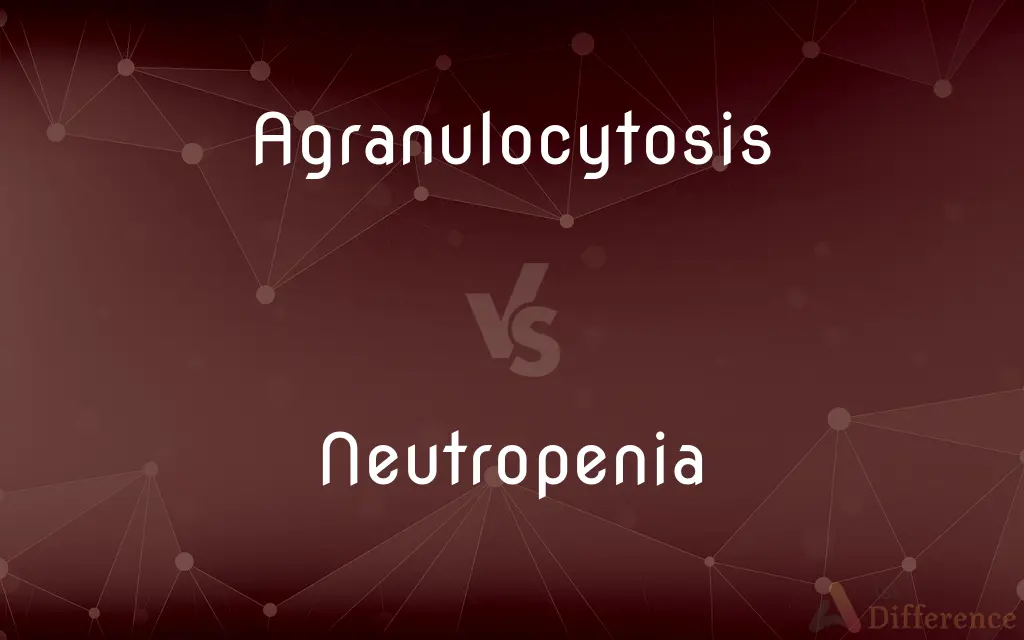Agranulocytosis vs. Neutropenia — What's the Difference?
Edited by Tayyaba Rehman — By Fiza Rafique — Updated on March 26, 2024
Agranulocytosis is a severe form of neutropenia characterized by an extremely low level of granulocytes, while neutropenia is a condition marked by reduced neutrophils in the blood.

Difference Between Agranulocytosis and Neutropenia
Table of Contents
ADVERTISEMENT
Key Differences
Agranulocytosis is an extreme form of neutropenia, where the white blood cell (granulocyte) count is critically low, leading to a high risk of infection. Neutropenia, on the other hand, refers to a decreased number of neutrophils, a type of granulocyte, which are essential for fighting infections. While both conditions result in an increased susceptibility to infections, agranulocytosis presents a more severe risk due to the near absence of granulocytes.
The causes of agranulocytosis can include certain medications, autoimmune disorders, and bone marrow diseases, which lead to the suppression or destruction of bone marrow cells. Neutropenia may also be caused by similar factors but can occur in less severe forms, such as mild neutropenia, where the risk of infection is not as pronounced as in agranulocytosis.
Diagnosing agranulocytosis involves blood tests to measure the absolute neutrophil count (ANC) and may require bone marrow biopsies to determine the underlying cause. Neutropenia is similarly diagnosed through blood tests, but the approach to identifying its cause might be less aggressive if the condition is mild and not accompanied by severe infections.
Treatment for agranulocytosis often requires hospitalization to manage and prevent infections, and may include antibiotics, antifungal medications, and medications to stimulate white blood cell production. Neutropenia treatment varies based on its severity and cause, ranging from monitoring in mild cases to the use of growth factors and antibiotics in more severe cases.
Both conditions necessitate careful monitoring and management to prevent infections. However, the approach to treatment and the prognosis significantly differ, with agranulocytosis requiring more intensive intervention due to its potential to rapidly become life-threatening.
ADVERTISEMENT
Comparison Chart
Definition
A severe form of neutropenia with a critical reduction in granulocytes.
A reduction in the number of neutrophils in the blood.
Severity
Extremely severe, with a high risk of infection.
Can range from mild to severe.
Causes
Medications, autoimmune disorders, bone marrow diseases.
Similar to agranulocytosis but also includes less severe conditions.
Diagnosis
Blood tests, bone marrow biopsy for underlying causes.
Blood tests, with less aggressive pursuit of underlying cause in mild cases.
Treatment
Hospitalization, antibiotics, antifungal medications, growth factors.
Varies; monitoring, growth factors, antibiotics depending on severity.
Risk of Infection
Very high due to near absence of granulocytes.
Ranges based on severity, higher in severe cases.
Compare with Definitions
Agranulocytosis
Drugs used to prevent or treat bacterial infections.
Antibiotics are essential in treating infections in patients with agranulocytosis.
Neutropenia
Substances that stimulate the bone marrow to produce more blood cells.
In severe cases of neutropenia, growth factors may be administered to increase neutrophil counts.
Agranulocytosis
A critical condition characterized by an extremely low level of granulocytes.
After her diagnosis with agranulocytosis, she was immediately hospitalized to prevent infections.
Neutropenia
A type of white blood cell crucial for combating infections.
Patients with neutropenia have fewer neutrophils available to fight off infections.
Agranulocytosis
The soft tissue inside bones that produces blood cells.
A bone marrow biopsy can determine if agranulocytosis is due to bone marrow failure.
Neutropenia
A less severe form of neutropenia, posing minimal risk of infection.
He was diagnosed with mild neutropenia but required no immediate treatment.
Agranulocytosis
A type of white blood cell important in fighting infections.
Agranulocytosis results in a dangerous depletion of granulocytes.
Neutropenia
The act of regularly checking medical conditions.
Regular monitoring is crucial for patients with neutropenia to detect any dangerous drops in neutrophil levels.
Agranulocytosis
A measure of the number of neutrophils in the blood.
Doctors measure ANC to assess the severity of agranulocytosis.
Neutropenia
A condition marked by a lower-than-normal number of neutrophils.
Neutropenia can lead to an increased risk of infections.
Agranulocytosis
Agranulocytosis, also known as agranulosis or granulopenia, is an acute condition involving a severe and dangerous lowered white blood cell count (leukopenia, most commonly of neutrophils) and thus causing a neutropenia in the circulating blood. It is a severe lack of one major class of infection-fighting white blood cells.
Neutropenia
Neutropenia is an abnormally low concentration of neutrophils (a type of white blood cell) in the blood. Neutrophils make up the majority of circulating white blood cells and serve as the primary defense against infections by destroying bacteria, bacterial fragments and immunoglobulin-bound viruses in the blood.
Agranulocytosis
An acute condition characterized by a marked decrease in circulating granulocytes, especially neutrophils, and often leading to infection. It is usually drug-induced or caused by exposure to radiation or toxic chemicals.
Neutropenia
An abnormally low level of neutrophils in the circulating blood.
Agranulocytosis
(disease) An acute condition involving a severe and dangerous leukopenia, particularly of neutrophils, causing a neutropenia in the circulating blood.
Neutropenia
A hematological disorder characterized by an abnormally low neutrophil count.
Agranulocytosis
An acute blood disorder (often caused by radiation or drug therapy) characterized by severe reduction in granulocytes
Neutropenia
Leukopenia in which the decrease is primarily in number of neutrophils (the chief phagocytic leukocyte)
Common Curiosities
How are agranulocytosis and neutropenia diagnosed?
Both are diagnosed through blood tests measuring the absolute neutrophil count, with additional tests for agranulocytosis to find the cause.
What distinguishes agranulocytosis from neutropenia?
Agranulocytosis is a severe form of neutropenia characterized by a very low level of granulocytes, posing a high risk of infections.
How does one manage neutropenia?
Management varies from monitoring in mild cases to the use of antibiotics and growth factors in more severe cases.
What causes agranulocytosis and neutropenia?
Causes include certain medications, autoimmune disorders, and diseases affecting the bone marrow.
Is neutropenia always serious?
The severity of neutropenia varies; mild cases may require minimal treatment, while severe cases can be life-threatening.
Can agranulocytosis be treated?
Yes, with prompt medical intervention, including hospitalization, antibiotics, and possibly medications to stimulate white blood cell production.
What role do antibiotics play in treating these conditions?
Antibiotics are used to prevent or treat infections, which patients with these conditions are highly susceptible to.
Can agranulocytosis lead to death?
If untreated, the high risk of infection in agranulocytosis can be fatal, making prompt treatment crucial.
What's the difference in treatment between agranulocytosis and neutropenia?
Agranulocytosis usually requires more aggressive treatment, including hospitalization, while neutropenia treatment varies based on severity.
Are there preventive measures for agranulocytosis and neutropenia?
Avoiding known triggers, such as certain medications, and regular monitoring can help in some cases.
Can both conditions recur?
Yes, especially if the underlying causes are not resolved or if exposure to triggers continues.
Share Your Discovery

Previous Comparison
Regulon vs. Operon
Next Comparison
Vagarity vs. VagaryAuthor Spotlight
Written by
Fiza RafiqueFiza Rafique is a skilled content writer at AskDifference.com, where she meticulously refines and enhances written pieces. Drawing from her vast editorial expertise, Fiza ensures clarity, accuracy, and precision in every article. Passionate about language, she continually seeks to elevate the quality of content for readers worldwide.
Edited by
Tayyaba RehmanTayyaba Rehman is a distinguished writer, currently serving as a primary contributor to askdifference.com. As a researcher in semantics and etymology, Tayyaba's passion for the complexity of languages and their distinctions has found a perfect home on the platform. Tayyaba delves into the intricacies of language, distinguishing between commonly confused words and phrases, thereby providing clarity for readers worldwide.















































